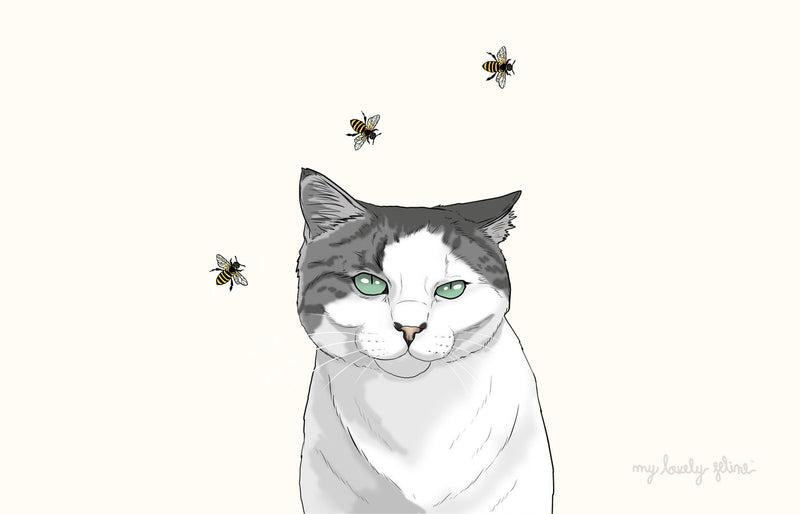|
As cat owners, we do everything we can to keep our feline friends safe and happy. But what happens when our curious kitties encounter a buzzing bee? While cats are naturally curious creatures, their playful nature can sometimes lead to unexpected encounters with stinging insects. If your beloved feline has been stung by a bee, it's important to know how to respond quickly and effectively. In this article, we'll explore the signs of a cat sting, the potential risks, and most importantly, what you can do to provide immediate relief to your furry friend. From understanding the symptoms to learning how to prevent future encounters, we'll equip you with the knowledge you need to ensure your cat's well-being. So, let's dive in and discover the buzz about cats and bees, and what steps you can take to keep your feline friend safe and sound. |
Understanding the Risks of Bee Stings for Cats
Bee stings can be more than just a painful experience for cats. They can also pose serious health risks. When a cat gets stung by a bee, the venom from the sting can cause an allergic reaction. This allergic reaction can range from mild to severe, depending on the individual cat's sensitivity to bee venom.
In some cases, a cat may experience localized swelling, redness, and discomfort at the site of the sting. However, more severe reactions can include difficulty breathing, excessive drooling, vomiting, and even collapse. It's important to note that cats with a known history of bee sting allergies are at a higher risk of experiencing a severe reaction.
Bee stings can also lead to secondary infections if left untreated. When a bee stinger is left behind in the cat's skin, it can cause an infection in the area surrounding the sting. This can result in additional pain and discomfort for your furry friend. Therefore, it's crucial to pay close attention to your cat's behavior and take prompt action if you suspect they have been stung by a bee.
Identifying the Signs of a Cat Being Stung by a Bee
Identifying whether your cat has been stung by a bee can sometimes be a challenging task. Cats may not always show obvious signs of distress immediately after being stung. However, there are some common symptoms to look out for.
One of the most noticeable signs is excessive pawing or scratching at the affected area. Cats may also display signs of agitation or restlessness. They may try to lick or bite the area, indicating discomfort. Swelling, redness, and tenderness around the sting site are also common indicators. If you notice any of these signs, it's important to act quickly to provide relief to your cat.
It's worth mentioning that some cats may have a more severe reaction to bee stings compared to others. If your cat is showing signs of difficulty breathing, vomiting, or collapse, it's crucial to seek immediate veterinary care. These symptoms may indicate a severe allergic reaction that requires immediate attention.
Immediate Steps to Take When Your Cat Gets Stung
When you discover that your cat has been stung by a bee, your immediate goal is to provide relief and minimize their discomfort. Here are some steps you can take right away:
1. **Remove the stinger (if present):** Check the sting site for a stinger. If you can see it, use a pair of tweezers or your fingernails to gently remove it. Be careful not to squeeze the venom sac at the end of the stinger, as this can release more venom into the cat's skin.
2. **Apply a cold compress:** Wrap an ice pack or a cold, damp cloth in a towel and apply it to the affected area. The cold temperature can help reduce swelling and provide immediate relief to your cat.
3. **Offer water:** It's important to keep your cat hydrated after a bee sting. Offer them a bowl of fresh water to encourage them to drink. Hydration is crucial for their overall well-being and can aid in flushing out toxins from their system.
Remember, these steps are meant to provide immediate relief and should not replace veterinary care. If your cat's symptoms worsen or if you're unsure about the severity of the reaction, it's best to consult with a veterinarian.
Home Remedies for Bee Stings in Cats
While seeking veterinary care is always the best course of action when your cat gets stung by a bee, there are some home remedies you can try to provide additional comfort to your furry friend. These remedies can help alleviate symptoms and promote healing. Here are a few options:
1. **Baking soda paste:** Mix a small amount of baking soda with water to create a paste. Apply the paste to the sting site and let it sit for a few minutes before rinsing off. Baking soda has natural anti-inflammatory properties that can help reduce swelling and discomfort.
2. **Aloe vera gel:** Aloe vera gel is known for its soothing properties. Apply a small amount of pure aloe vera gel to the sting site to help alleviate itching and promote healing.
3. **Calendula cream:** Calendula cream is derived from marigold flowers and has anti-inflammatory properties. Apply a small amount to the sting site to provide relief and promote healing.
It's important to note that these home remedies should only be used as a temporary measure until you can consult with a veterinarian. They are not a substitute for professional medical advice.
When to Seek Veterinary Care for a Bee Sting
While mild reactions to bee stings in cats can often be treated at home, there are cases where veterinary intervention is necessary. If your cat exhibits any of the following symptoms, it's crucial to seek immediate veterinary care:
1. **Difficulty breathing or wheezing:** This can indicate a severe allergic reaction that requires immediate medical attention.
2. **Swelling that spreads beyond the sting site:** Excessive swelling or swelling that spreads to other parts of the body may indicate a more serious reaction.
3. **Vomiting or diarrhea:** These symptoms can be a sign of a systemic allergic reaction.
4. **Lethargy or collapse:** If your cat appears weak, lethargic, or collapses, it's important to seek emergency veterinary care.
Remember, it's always better to err on the side of caution when it comes to your cat's health. If you're unsure about the severity of the reaction or if your cat's condition worsens, don't hesitate to contact your veterinarian.
Preventing Bee Stings in Cats
Prevention is key when it comes to keeping your cat safe from bee stings. Here are some measures you can take to minimize the risk:
1. **Keep your cat indoors:** While it may not always be possible to keep your cat indoors at all times, limiting their outdoor access can significantly reduce the chances of encounters with bees and other stinging insects.
2. **Avoid flowering plants:** Bees are naturally attracted to flowers, so minimizing your cat's exposure to flowering plants can help reduce the risk of bee stings. Consider planting bee-friendly flowers away from areas where your cat spends most of their time.
3. **Monitor outdoor activities:** If you do allow your cat outside, supervise their activities to ensure they don't come into contact with bees. Keep an eye out for buzzing sounds or signs of bees in the vicinity.
4. **Consider bee repellents:** There are natural bee repellents available that can help deter bees from your cat's immediate surroundings. These repellents typically use essential oils that are safe for cats but repel bees.
Remember, prevention is always better than cure. By taking proactive steps to minimize your cat's exposure to bees, you can significantly reduce the chances of stings and potential allergic reactions. br/>
Other Potential Dangers for Cats in Relation to Bees
While bee stings can be a significant concern for cats, there are other potential dangers to be aware of. Cats are curious by nature, and their curiosity can sometimes lead them to investigate beehives. Beehives can pose a threat to cats, as a swarm of bees can cause multiple stings and potentially lead to a severe allergic reaction. If you notice a beehive in your vicinity, it's important to take steps to ensure your cat's safety, such as keeping them away from the area or contacting a professional beekeeper to remove the hive.
Additionally, it's worth noting that in some cases, cats may accidentally ingest bees while attempting to catch or play with them. Ingesting a bee can lead to stings in the mouth or throat, which can be particularly dangerous. If you suspect your cat has ingested a bee or is experiencing difficulty swallowing, it's crucial to seek immediate veterinary care.
The Importance of Bee-Friendly Practices for Cat Owners
As cat owners, we have a responsibility to not only keep our feline friends safe but also contribute to the well-being of the environment. Bees play a crucial role in pollination and the health of ecosystems. By adopting bee-friendly practices, such as planting bee-friendly flowers and avoiding the use of pesticides harmful to bees, you can help support bee populations and create a safer environment for both cats and bees. Encouraging bee-friendly practices not only benefits the environment but also reduces the risk of potential encounters between cats and bees.
Conclusion
Encountering a bee can be a curious and potentially dangerous situation for our feline friends. Being aware of the risks, symptoms, and appropriate actions to take can make all the difference in ensuring your cat's well-being. By understanding the signs of a cat sting, providing immediate relief, and taking preventive measures, you can help keep your cat safe from bee stings.
Remember, if you suspect a severe allergic reaction or are unsure about the severity of your cat's symptoms, always consult with a veterinarian. By being proactive and knowledgeable, you can protect your furry friend and enjoy a worry-free environment for both cats and bees.




